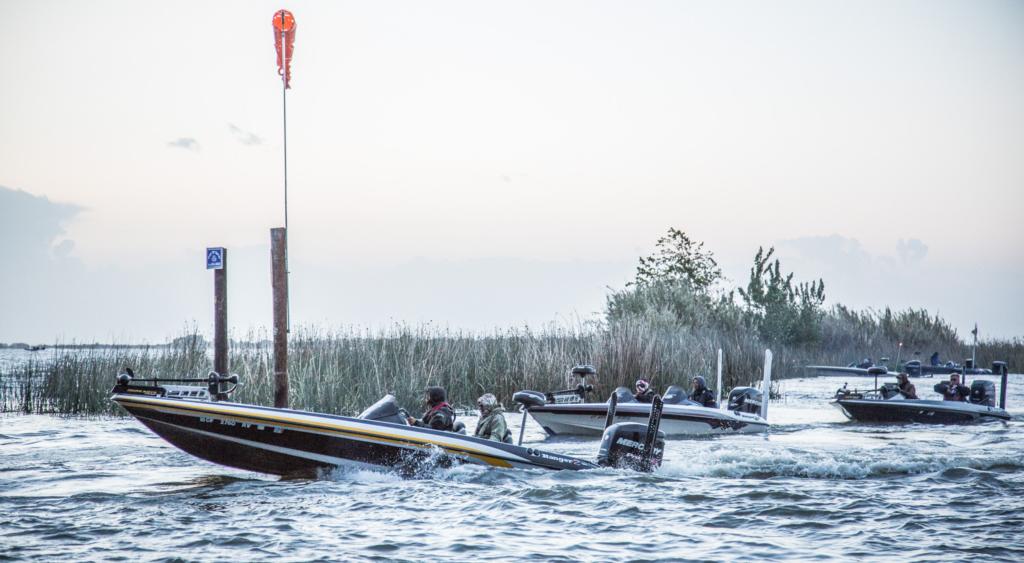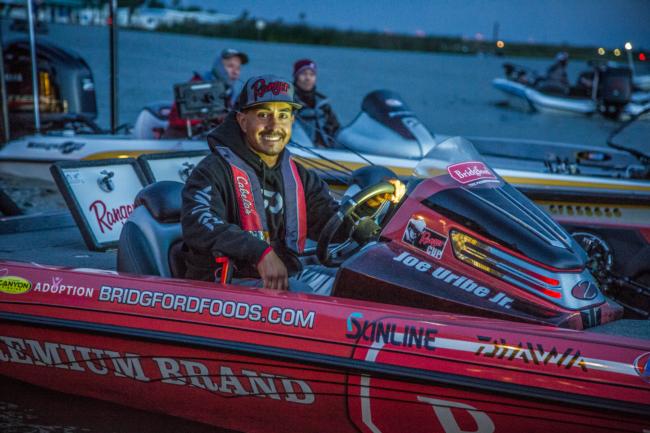Anything Goes at the Cal Delta
Prespawn, spawn and postspawn fish in play at Western Division Stop No. 2

There are 127 pros entered in the Rayovac FLW Series Western Division tournament presented by Ranger at the California Delta this week. If you asked them all what their baits or tactics are for the first day of competition today, you might get 127 different answers.
At some fisheries that FLW’s tournament circuits visit, such varied and often vague responses from pros when they’re prompted for fishing info are the result of them attempting to stealthily hide their fishing patterns. That’s not exactly the case at this tournament.
The fact is, the California Delta is one of the most vast and varied fisheries that hosts FLW events. It’s a collection of unique mini-fisheries all rolled into one, with dirty water, clean water, tons of vegetation and other factors tossed into the mix. It’s a tidal fishery, so the water levels and currents fluctuate throughout each day. And, of course, it’s spring in California, and because of the vastness of the Sacramento and San Joaquin rivers and the delta system they feed, with its 1,000 miles of waterways, there are populations of bass in all stages of the spawn in their own little geographic areas.
Whew, that’s a lot of factors for pros to consider as they prepare for this three-day derby. Here’s what we can guarantee: Competitors can catch fish doing just about anything they want, and just about any tactic could tempt a double-digit bass to bite. Also, half a dozen of the Western Division favorites surveyed before takeoff believe that we’ll see at least a couple of 30-pound bags this week. One even revealed that he’s seen two bass in the “teens” cruising the banks.
As they prepared for this week’s event, most pros in the field paid close attention to a few major tournaments on the Delta last weekend – one being the Bassmaster Elite Series event that launched up the Sacramento River, which Justin Lucas won with a four-day total of 82 pounds, 14 ounces.
Many of the top pros in the Elite event were sight-fishing. California pro Jason Borofka, who’s fishing the Rayovac this week, was also on the Delta last weekend in a different tournament, where he took fourth place out of about 100 boats with 46 pounds for two days. He says his four biggest fish were caught by sight-fishing, and there’ll be more caught off beds this week. Though, Borofka isn’t sure the sight bite alone can carry a pro to the win.
“There’s another wave moving in,” he says, “but only in certain areas. The rest of the fish being caught are mostly postspawn, and they’ve been picked on. I think we’ll see bigger weights [than at the Elite event] in the top 10, but there’ll be a drastic drop-off below that in the standings.”
Delta expert Ken Mah echoed Borofka’s thoughts regarding the spawn and the difficulty of winning this tournament by looking at bedding fish. Both he and Borofka blame the tide – plus forecasts for steady winds – for the sight-bite challenge.
“I think there are still some fish to be caught on beds, but I think it’s going to be tougher,” says Mah. “They [the Elite pros] were at the front end of the full moon, and they had the right tide to see them. I’m not sight-fishing, though if I see one on a bed that’ll help, I’ll catch it.”
The challenge with the tide relates to the timing, which is always a concern in tidal tournaments. The high tide today should peak at about 7 a.m., which is an hour after takeoff. That means pros will have to wait until early afternoon for the tide to bottom out, which is when the sight bite is prime because the fish obviously have to spawn below the low-tide water level, and in most areas they’re not visible to anglers until the water nearly hits its lowest point. Though, some pros say they’ve found quality bass on beds during low-tide periods in practice that they could catch by blind-casting during high or falling tides.
Figuring out the tide was really the biggest factor that anglers discussed at registration last night and again this morning. Joe Uribe Jr., who won the first Western Division event at Lake Havasu, says his best bite is at low tide. Last year’s Delta champ Mark Daniels Jr. says he prefers the high tide, and casting to fish he’s found but that can’t see him with the extra water above them. Borofka is going to combine multiple patterns, with a plan for the early morning high tide and others for periods of outgoing and low tide. Mah is going to “run the tide,” meaning he’ll jet across the Delta, keying on very precise areas where the tide is “just right,” then shooting to the next spot once the water level changes. He’ll track the rise and fall as it progresses across the Delta.
All the change will probably leave some anglers scratching their heads, though there are enough regulars here that someone will figure out which water level, or which tidal switch, turns on these fish.
“We’ll have the tail end of the high tide, the high switch, outgoing and, depending on boat draw, possibly the bottom end of the low tide,” Mah says. “Historically, this tidal timing is best for big weights this time of year.”
A bigger change has also occurred on the Delta this season. According to several competitors familiar with local fisheries management, wildlife officials started spraying grass earlier in the year in 2015 in order to clear out some areas that had become choked with vegetation. That’s part of the reason the sight bite was so good last weekend – guys could actually see the fish on their beds because they weren’t obstructed by grass. It’s also changed a lot of the spots that produced last season. The change is good for locals, who’ve seen just about every scenario at the Delta, and bad for the out-of-towners, like Vu Au, who revisited all the spots where he’s caught fish the last two seasons, only to strike out in practice. He had to start from scratch in yesterday’s final practice outing.
So what else is likely to produce this week? Many bass are already guarding fry, so making precise pitches with a big jointed, waking swimbait or a gurgling prop bait and pestering them overhead has worked in practice. Pros have also caught them frogging and flipping, slow-fishing with Senkos and other plastics, or tossing reaction baits such as ChatterBaits and square-bill crankbaits.
With all those patterns working, Mah thinks the winner will have figured out at least two key baits or presentations. Borofka agrees, and adds that the reaction bite is very strong in the morning during high tide, while a slower approach could then be used in the middle of the day or the afternoon.
Finally, one remaining wild card is the possibility of uncovering a tucked-away area that most in the field have overlooked, but that is home to a wad of Delta giants. Charlie Weyer, a favorite in this tournament, thinks he’s found one such area – actually a handful of areas clustered together. He’s avoided all the spots where last week’s Elite Series pros fished in order to stay away from the crowd that’s surely to haunt those winning areas in this event, and he hasn’t seen another competitor all week. Weyer thinks he’s on the kind of fish that could win this tournament.
“You can catch them about any way you want, but there are techniques that catch big fish. I have to fish really, really slow,” he says. “If you start running around chasing the tide, I don’t think that’ll do it. I’ll bounce around to four areas. I’m not junk-fishing. You have to know exactly where they’re at because there are huge stretches of dead water. I’m also fishing clear water and staying away from dirty water. I’m not as confident I can catch them in dirty water.”
As you can see, everything is in play on the Delta this week. Expect to see a lot of variety, a smattering of Cali-style big-bait lobbing, some frogging and flipping, and enough sight-fishing to make this a true “anything goes tournament.” Hopefully, the options will lead to a parade of California beauties walked across the weigh-in stage.
Conditions
Sunrise: 6:05 a.m.
Water temperature: mid-60s
Air temperature at launch: 56 degrees
Forecast high: 75 degrees
Wind: NW at 10 mph switching to NE at 12 to 16 mph mid-morning
Weather: mix of clouds and sun during the morning, giving way to cloudy skies in the afternoon, with 20 percent chance of rain and stray thunderstorms possible
Tournament Details
Format:
All boaters and co-anglers will compete for two days. The top 10 boaters and co-anglers based on cumulative weight after two days of competition will advance to the third and final round, with the winner determined by the heaviest cumulative three-day weight.
Presenting sponsor: Ranger
Host: City of Oakley
Takeoff time: 6:00 a.m. PT
Takeoff location: Russo's Marina, 3995 Willow Road, Bethel Island, CA
Weigh-in time:
Days 1 and 2: 2:00 p.m. PT
Day 3: 2:30 p.m. PT
Weigh-in location: Russo’s Marina
More information
For complete details and updated information, visit the Rayovac FLW Series tournament page. For regular updates, photos, tournament news and more, follow the Rayovac FLW Series on Facebook at Facebook.com/FLWFishing and on Twitter at Twitter.com/FLWFishing.
